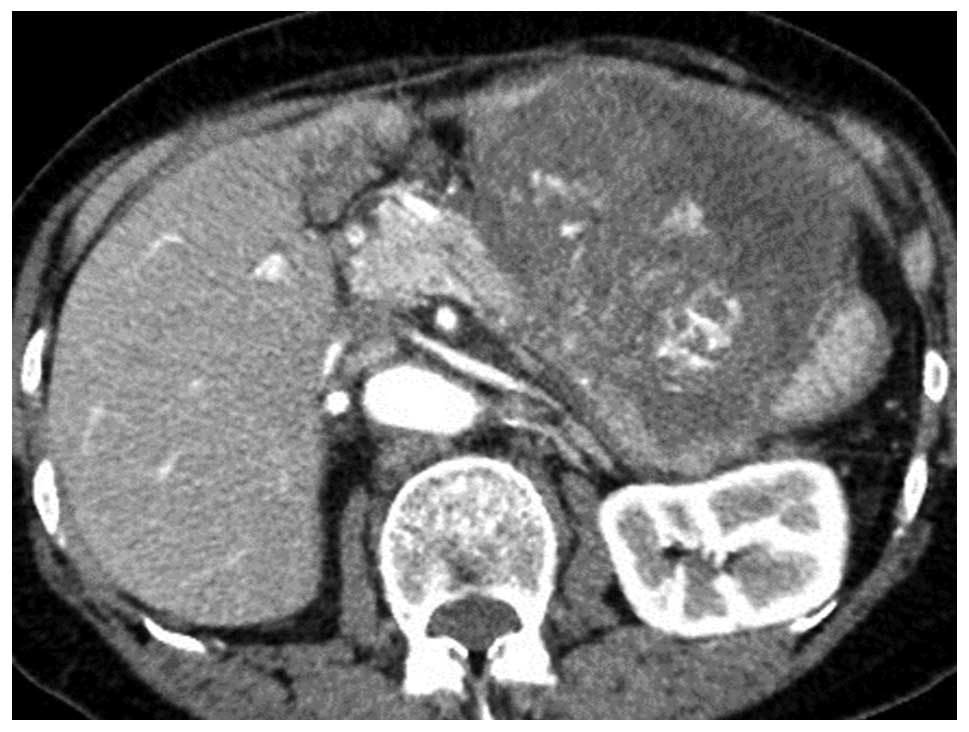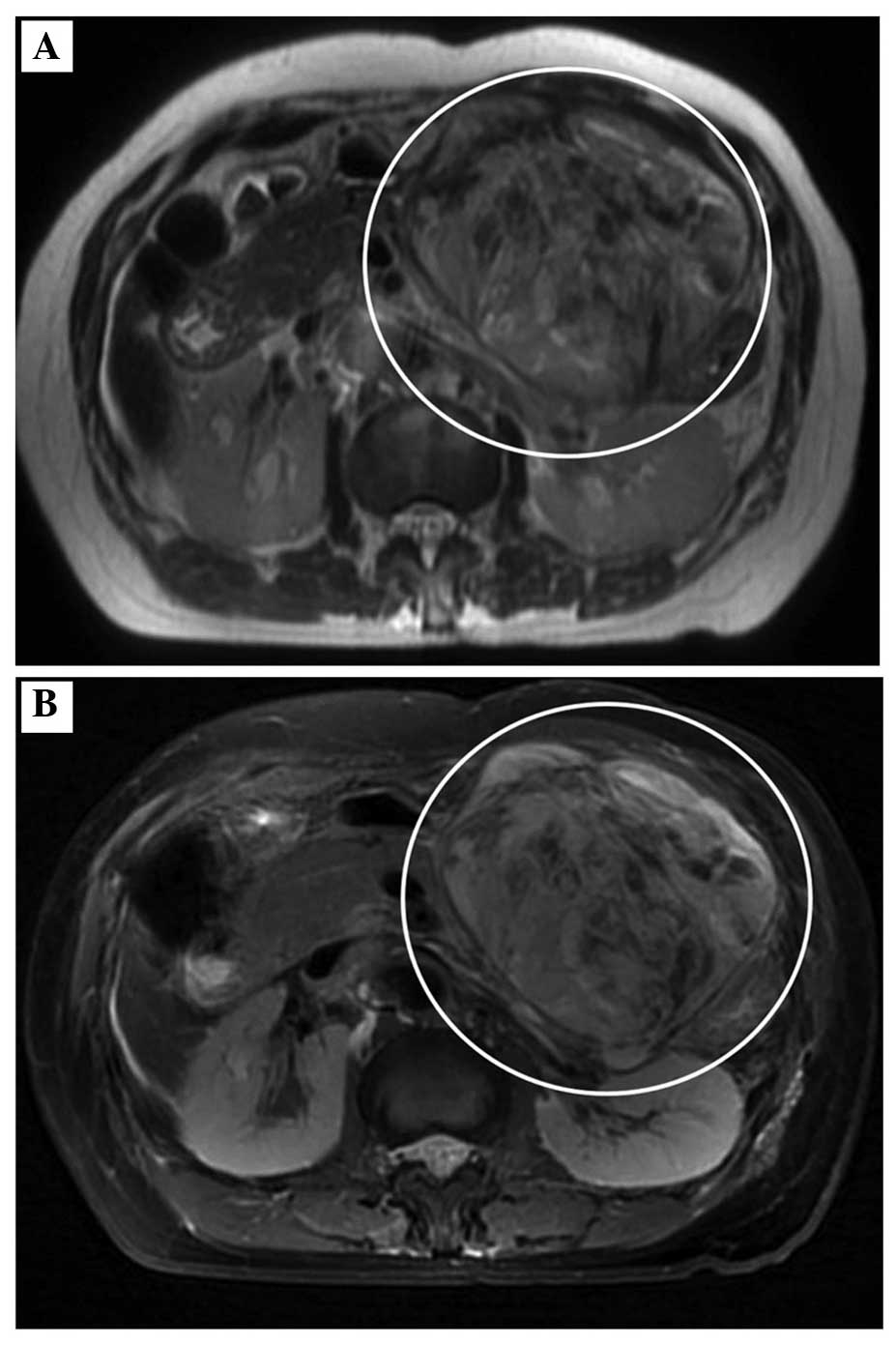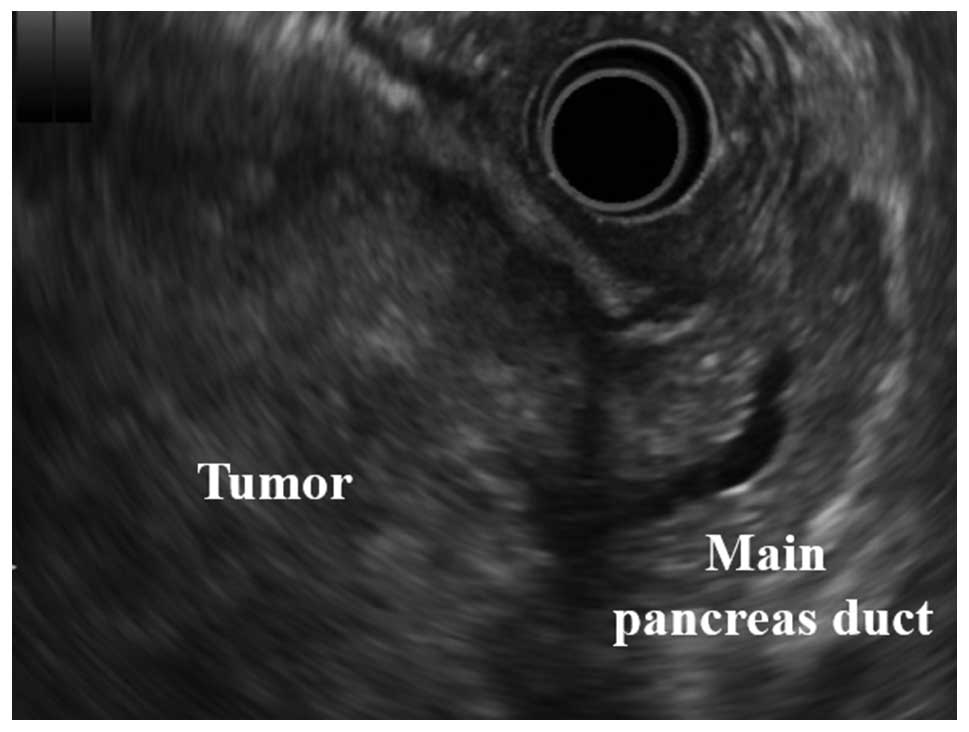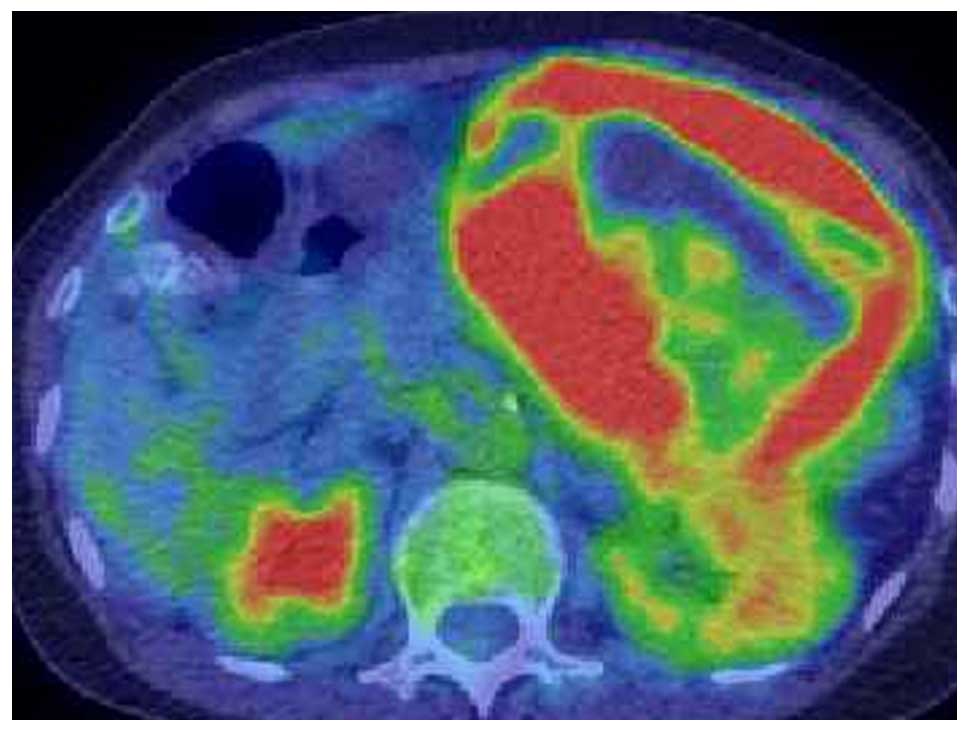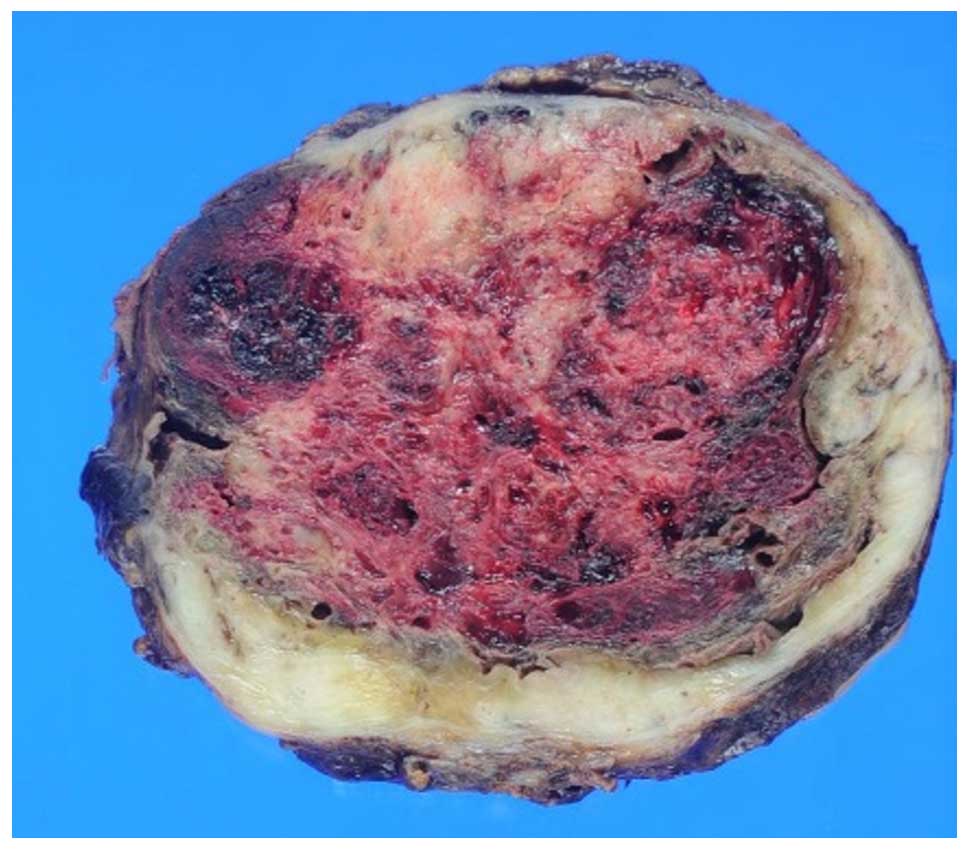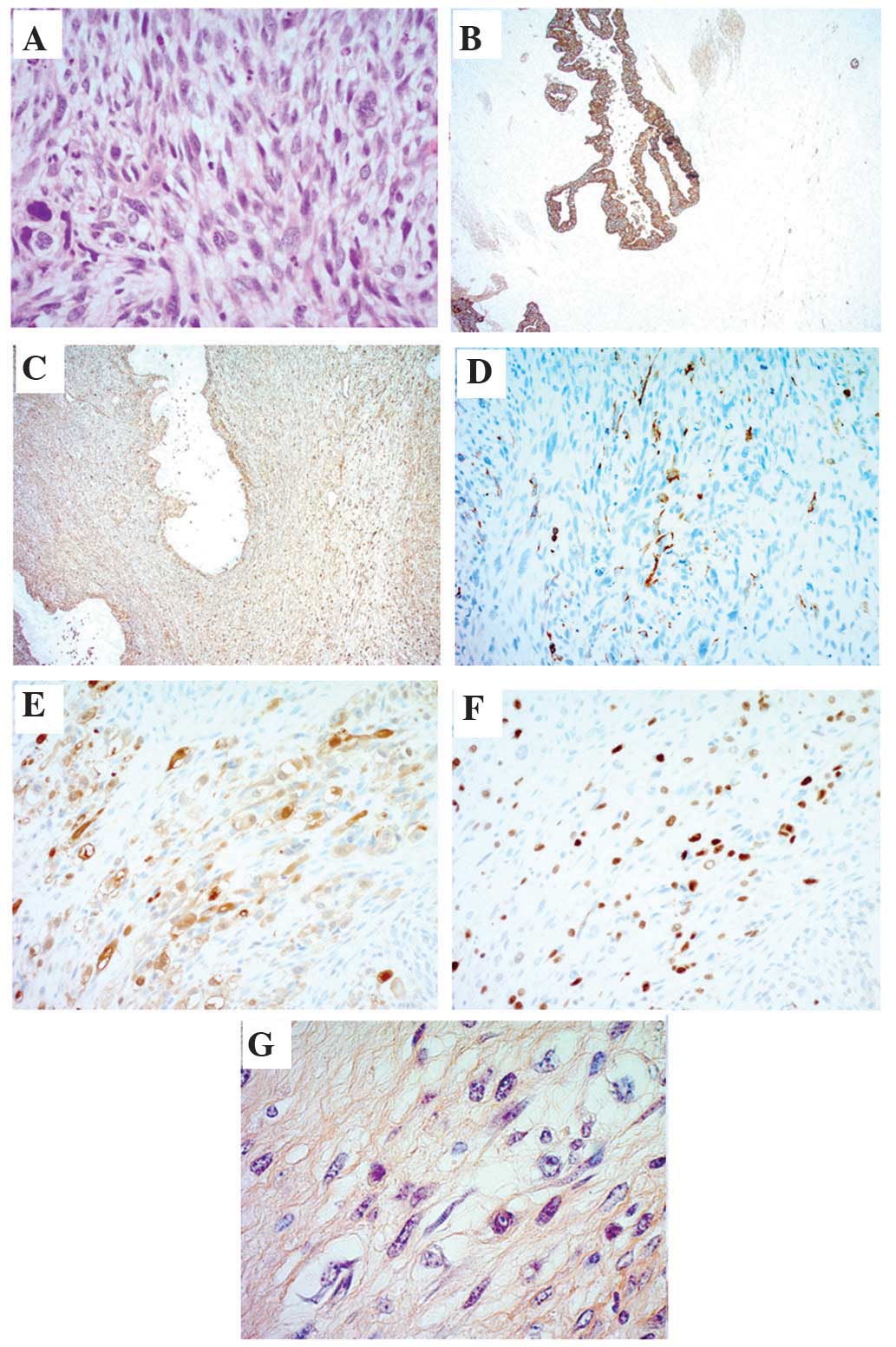A spindle cell anaplastic pancreatic carcinoma with rhabdoid features following curative resection
- Authors:
- Published online on: May 30, 2016 https://doi.org/10.3892/mco.2016.914
- Pages: 327-330
Abstract
Introduction
Since anaplastic pancreatic carcinoma (ANPC) is rare and accounts for only 2–7% of all pancreatic carcinoma cases, its clinical features and surgical outcomes remain to be elucidated (1,2). A total of three pathological subtypes of ANPC exist: Spindle cell carcinoma, giant cell carcinoma, and pleomorphic carcinoma. Surgical resection is the only curative therapy for patients with ANPC since no effective systemic chemotherapy or other interventions are available; however, long-term survival remains to be achieved in patients with ANPC even following curative surgery (1,3). ANPC is often associated with a delay in clinical presentation as a result of its asymptomatic nature until the tumor has progressed to an advanced stage. In several reports that have been published since the early 1900s, ANPC was referred to as ‘giant-cell tumor’, ‘undifferentiated carcinoma’ with or without osteoclast-like giant cells and ‘pleomorphic carcinoma’ of the pancreas (3–6).
Establishing the precise pre-operative diagnosis is difficult due to the radiological findings being atypical and similar to those of gastrointestinal stromal tumors, mucinous cyst adenocarcinomas and pancreatic carcinomas. Upon admission, the present patient's tumor was already huge and revealed enhanced rims with hypodense lesions on computed tomography (CT) scans, which appears to be a common radiological feature of ANPCs (1).
Of the three subtypes, spindle cell carcinoma is the most aggressive subtype of sarcomatoid carcinoma and currently no effective systemic chemotherapies or other interventions are available. According to previous reports, two patients with ANPC with rhabdoid features had dismal prognoses following surgical intervention (7,8). The present study described a case of spindle cell ANPC that exhibited aggressive growth following emergency curative surgery.
Case report
A 74-year-old woman without any previous medical history was admitted to our hospital in April 2015. Physical examination revealed a firm tumor located in her left upper quadrant. Abdominal ultrasonography detected a giant cystic tumor containing high and low echoic lesions in the body and tail of the pancreas. Admission laboratory tests revealed that the serum levels of carbohydrate antigen 19-9, carcinoembryonic antigen and DUPAN-2 were elevated (78.0, 36.6 and 1,200 U/ml, respectively). On contrast-enhanced CT scanning, the tumor occupying the left upper and lower abdomen was measured to be 9.5×8.0 cm. This tumor consisted of multilocular cystic components, both the rim and core of the tumor were strongly enhanced on the arterial phase CT images (Fig. 1). A dilatation of the distal main pancreatic duct was evident, however, no distant metastases, lymph node swelling or ascites were detected. The solid tumor exhibited low signal intensity on T1-weighted magnetic resonance imaging (MRI) and relatively high signal intensity on T2-weighted MRI (Fig. 2). Intraductal ultrasonography demonstrated a huge solid tumor derived from the body of the pancreas and located within a clear margin from the stomach (Fig. 3). 18F-fluorodeoxyglucose (FDG)-positron emission tomography/CT identified no distant metastasis, and FDG accumulation was detected only in the tumor lesion (Fig. 4). The differential diagnoses were pancreatic adenocarcinoma, gastrointestinal stromal tumor, endocrine cell carcinoma or solid pseudopapillary neoplasm of the pancreas. At 3 weeks after the initial admission of the patient, massive ascites suddenly emerged and the tumor increased in from a size of 9.5 cm to 11 cm in the maximal diameter. The patient experienced an increase in acute abdominal pain, which was uncontrollable by analgesic medications. During an emergency laparotomy, bloody ascites of 1,700 ml was observed; however, peritoneal dissemination or liver metastasis was not detected. A distal pancreatectomy and a splenectomy with regional lymph node dissection were performed. The operation lasted 4 h 13 min. Blood loss during the operation was 1,300 ml and the bloody ascites volume was 1,700 ml.
On macroscopic observation, the tumor was 11×12 cm, and its appearance was elastic, hard and a white mass (Fig. 5). All specimens were processed in a routine manner for paraffin embedding and 5 µm-thick sections were cut and stained with hematoxylin and eosin. Histopathological analysis of the sections revealed that the tumor cells had acquired dedifferentiated rhabdoid features and were positive for phosphotungstic acid-hematoxylin. Additionally, the tumor cells were positive for phosphotungstic acid-hematoxylin (PTAH) stain, myoglobin (cat. no. H0309; Nichilei Biosciences, Inc., Tokyo, Japan), myogenin (F5D; cat. no. 1328706B; Dako, Carpinteria, CA, USA), vimentin (V9; cat. no. H1402; Dako) and cytokeratin 5.2 (CAM52; cat. no. D04930; Roche Diagnostics, Indianapolis, IN, USA; Fig. 6). Therefore, a diagnosis of spindle cell ANPC with rhabdoid features was made based on the pathological findings. The patient was discharged 14 days post-operation without any complications. The patient succumbed to mortality 8 months following the surgery while undergoing systemic adjuvant chemotherapy.
Discussion
Spindle cell ANPC has been reported to have the worst prognosis of the three ANPC subtypes (3). The presence of rhabdoid features in ANPC is extremely rare; only two such cases have been reported to date (7,8). ANPC accounts for 2–7% of all pancreatic carcinoma cases. The present case exhibited an atypical clinical presentation and radiological findings, which allowed the present study to distinguish ANPC from gastrointestinal stromal tumor, solitary pseudopapillary neoplasms and pancreatic adenocarcinoma (1). Rapid tumor progression associated with massive ascites and uncontrollable abdominal pain occurred in the present case. Distal pancreatectomy and splenectomy were successfully performed to excise the giant tumor. Establishing the precise diagnosis was difficult due to the atypical radiological findings and tumor rarity. Although a huge tumor of the pancreas can be treated via surgical resection, the prognosis is poor even following surgery. Whenever possible, radical resection is recommended.
Although multiple case reports on ANPC have been published, the clinical presentation and surgical outcomes remain to be well investigated owing to the rarity of this disease (3,9–12). Upon admission of the patient, the radiological findings on contrast-enhanced CT was a huge tumor with a well-enhanced rim and hypodense areas in the center. On T1-weighted MRI, the tumor exhibited a low signal intensity, however, on T2-weighted MRI, the intensity of the signal was high.
Strobel et al (1) reported that ANPC is an aggressive type of pancreatic cancer with a dismal prognosis (1). Whenever possible, resection must be attempted, as it is the only treatment associated with a favorable prognosis. Although the clinical presentation and radiological findings are similar to those of pancreatic carcinoma, despite the lack of a precise diagnosis, curative surgery, whenever possible, must not be postponed. According to previous reports, obtaining pre-operative tissue samples does not change the therapeutic approach and is not advisable if the neoplasm appears resectable.
Neither an effective chemotherapy nor a standard regimen has been established for ANPC. Neoadjuvant chemotherapy was reported to be effective in one case, however, a standard regimen was not established (13). Wakatsuki et al (12) reported that a complete response was achieved following treatment with paclitaxel (PTX) (12). The present patient was treated with a nab-PTX and gemcitabine regimen, which failed to prevent multiple live metastases and peritoneal disseminations. PTX, a microtubule-stabilizing agent, has proven effective in treating several types of cancer, including breast, lung and ovarian. PTX exerts a particularly strong antitumor activity against certain types of sarcomas including angiosarcoma, Kaposi sarcoma and carcinosarcoma of the uterus and heart (14–16).
Strobel et al (1) compared clinical features and surgical outcomes of ANPC and pancreatic ductal adenocarcinoma. In the ANPC group, the duration of survival was significantly greater following R0/R1 resection compared with after palliative treatment. On the basis of the results of the previous study, the authors recommend that patients with ANPC be operated on whenever a potentially curative resection is possible since established systemic chemotherapy or alternative therapy is available. Among the several subtypes of ANPC, the spindle cell type exhibited the worst prognosis even following curative surgery; the prognosis was particularly poor in the present case of ANPC associated with rhabdoid features.
Immunohistochemistry revealed that the present patient's tumor was positive for cytokeratin 5.2, vimentin, desmin, myoglobin, myogenin and PTAH. Kane et al (3) reviewed the immunohistochemistry results of sarcomatoid components from previous reports and their results are consistent with the present positive findings for desmin, vimentin and myogenin (3). Notably, PTAH positivity, which represents cell dedifferentiation into striated muscle, was detected only in the present case. These phenotypic changes suggested that the epithelial cancer cells had transformed into mesenchymal cancer cells. The mechanism of such a transformation may be owing to the presence of cancer stem cells or the dedifferentiation of tumor cells into sarcoma cells.
In conclusion, ANPC is a rare and aggressive variant of pancreatic cancer. Spindle cell ANPC is associated with a particularly dismal prognosis. The only typical radiological feature of ANPC is a large tumor with an enhanced rim and a hypodense area in the center. As surgical resection is the only intervention that results in long-term survival in patients with ANPC, it must be attempted whenever possible. Further studies are required to clarify the mechanism of the aggressiveness of this type of cancer.
References
|
Strobel O, Hartwig W, Bergmann F, Hinz U, Hackert T, Grenacher L, Schneider L, Fritz S, Gaida MM, Büchler MW and Werner J: Anaplastic pancreatic cancer: Presentation, surgical management, and outcome. Surgery. 149:200–208. 2011. View Article : Google Scholar : PubMed/NCBI | |
|
Hoorens A, Prenzel K, Lemoine NR and Klöppel G: Undifferentiated carcinoma of the pancreas: Analysis of intermediate filament profile and Ki-ras mutations provides evidence of a ductal origin. J Pathol. 185:53–60. 1998. View Article : Google Scholar : PubMed/NCBI | |
|
Kane JR, Laskin WB, Matkowskyj KA, Villa C and Yeldandi AV: Sarcomatoid (spindle cell) carcinoma of the pancreas: A case report and review of the literature. Oncol Lett. 7:245–249. 2014.PubMed/NCBI | |
|
Fabre J, Planques J, Bouissou H and Sendrail-Pesque M: Sarcomatoid carcinoma of the pancreas. Toulouse Med. 62:85–98. 1961.(In French). PubMed/NCBI | |
|
Alguacil-Garcia A and Weiland LH: The histologic spectrum, prognosis, and histogenesis of the sarcomatoid carcinoma of the pancreas. Cancer. 39:1181–1189. 1977. View Article : Google Scholar : PubMed/NCBI | |
|
Ackerman NB, Aust JC, Bredenberg CE, Hanson VA Jr and Rogers LS: Problems in differentiating between pancreatic lymphoma and anaplastic carcinoma and their management. Ann Surg. 184:705–708. 1976. View Article : Google Scholar : PubMed/NCBI | |
|
Kuroda N, Iwamura S, Fujishima N, Ohara M, Hirouchi T, Mizuno K, Hayashi Y and Lee GH: Anaplastic carcinoma of the pancreas with rhabdoid features and hyaline globule-like structures. Med Mol Morphol. 40:168–171. 2007. View Article : Google Scholar : PubMed/NCBI | |
|
Kuroda N, Sawada T, Miyazaki E, Hayashi Y, Toi M, Naruse K, Fukui T, Nakayama H, Hiroi M, Taguchi H and Enzan H: Anaplastic carcinoma of the pancreas with rhabdoid features. Pathol Int. 50:57–62. 2000. View Article : Google Scholar : PubMed/NCBI | |
|
Sano M, Homma T, Hayashi E, Noda H, Amano Y, Tsujimura R, Yamada T, Quattrochi B and Nemoto N: Clinicopathological characteristics of anaplastic carcinoma of the pancreas with rhabdoid features. Virchows Arch. 465:531–538. 2014. View Article : Google Scholar : PubMed/NCBI | |
|
Okazaki M, Makino I, Kitagawa H, Nakanuma S, Hayashi H, Nakagawara H, Miyashita T, Tajima H, Takamura H and Ohta T: A case report of anaplastic carcinoma of the pancreas with remarkable intraductal tumor growth into the main pancreatic duct. World J Gastroenterol. 20:852–856. 2014. View Article : Google Scholar : PubMed/NCBI | |
|
Fujiogi M, Kobayashi T, Yasuno M and Tanaka M: Anaplastic carcinoma of the pancreas mimicking submucosal gastric tumor: A case report of a rare tumor. Case Rep Med. 2013:5232372013.PubMed/NCBI | |
|
Wakatsuki T, Irisawa A, Imamura H, Terashima M, Shibukawa G, Takagi T, Takahashi Y, Sato A, Sato M, Ikeda T, et al: Complete response of anaplastic pancreatic carcinoma to paclitaxel treatment selected by chemosensitivity testing. Int J Clin Oncol. 15:310–313. 2010. View Article : Google Scholar : PubMed/NCBI | |
|
Jones TS, Jones EL, McManus M, Shah R and Gajdos C: Multifocal anaplastic pancreatic carcinoma requiring neoadjuvant chemotherapy and total pancreatectomy: Report of a case. JOP. 14:289–291. 2013.PubMed/NCBI | |
|
Otsuki A, Watanabe Y, Nomura H, Futagami M, Yokoyama Y, Shibata K, Kamoi S, Arakawa A, Nishiyama H, Katsuta T, et al: Paclitaxel and carboplatin in patients with completely or optimally resected carcinosarcoma of the uterus: A phase II trial by the Japanese uterine sarcoma group and the tohoku gynecologic cancer unit. Int J Gynecol Cancer. 25:92–97. 2015. View Article : Google Scholar : PubMed/NCBI | |
|
Brambilla L, Romanelli A, Bellinvia M, Ferrucci S, Vinci M, Boneschi V, Miedico A and Tedeschi L: Weekly paclitaxel for advanced aggressive classic Kaposi sarcoma: Experience in 17 cases. Br J Dermatol. 158:1339–1344. 2008. View Article : Google Scholar : PubMed/NCBI | |
|
Ram Prabu MP, Thulkar S, Ray R and Bakhshi S: Primary cardiac angiosarcoma with good response to Paclitaxel. J Thorac Oncol. 6:1778–1779. 2011. View Article : Google Scholar : PubMed/NCBI |



